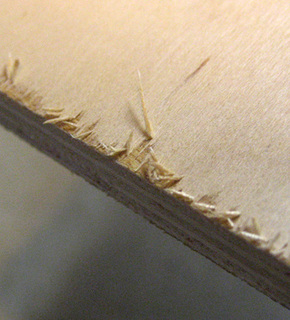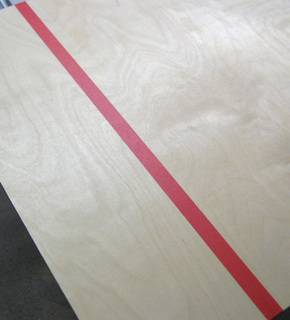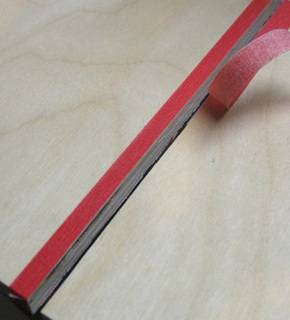The thin layers of plywood can often splinter and chip when cut with a power saw, resulting in an ugly edge that looks like this:
To prevent your cut line from tearing:
1. Always use an appropriate blade for plywood, and be sure that it’s sharp. The blade that came with your saw – whether you bought or rented it – is likely inadequate.
2. Be sure the good face of your plywood is closer to the outside of the blade. So on a table saw, the right side should be facing up, and when using a handheld circular saw, it should be facing down.
3. Then, add a strip of masking tape to both the top and bottom of the sheet, directly over the cut line.

4. Lastly, always make sure the saw is running and at full speed before making your cut. Push with a steady, consistent speed all the way through.
5. Peel back the tape, and marvel at your finely cut edge.
Note: This masking tape trick also works when using a drill or router.
make sure the blade is a fraction deeper than the plywood you are cutting
Wouldn’t the cut line get masked making the actual saw-line go off ? Or were you suggesting to use a transparent adhesive tape instead?
VC, The cut line needs to be marked on the masking tape, If you are using 2″ wide tape mark your cut line somewhere in the middle of the tape so you are cutting through the tape.
Thanks for clarification, Mark G;
You show on a crosscut but demonstrated cut “with the grain” not the same
Another trick is to realize that cutting with various saws results in a clean side, and a rough side.
The side which has the saw pulling towards it will be clean.
So, have the good edge facing away from you while cutting.
The most simple tip is to ensure that your blade is set to the correct depth. A few mm deeper than the wood is ideal. Safer too
Next time you try make this point it would pay to show the cut going through the same grain direction of the board. The torn plywood view shows the cut going through the grain whilst the clean view shows it going with the grain. Makes all the difference
thank you it was full use
Does the depth of your saw blade sticking beyond the surface of the plywood impact the quality of the cut?
@Rick – The depth of the saw blade should be set to prevent kickback on the saw. About 1/8″ further than the gullet of the blade teeth.
My experience has been that the tape does nothing. But everything else here is accurate! A sharp blade and cutting according to the grain make up 80% of a clean cut– the other 20% is setting the blade depth correctly, which isn’t mentioned here at all… ??? Set the blade so that it only clears the stock depth by 1/2″… You’ll notice far cleaner cuts doing that, than taping the wood.
Lmao, YES it will not splinter if you cut WITH the grain. Your tape wont help ic you cut across the grain like the first photo. Omw……..
When cutting plywood I do three things to prevent tearing when cutting crossgrain. Firstly I make a score line with a sharp craft knife along the cut line and secondly adjust the saw blade so that it is about 4mm deeper than the thickness of the ply. I then stick masking tape aalong the inside of the cut. Result – no tearing.
Firstly set the blade of the saw to a depth of 2 / 3 mm and score the surface, then set the blade to a depth of 3 / 4 mm greater than the depth of the board and do the final cut, use a good straight edge or guide and always make sure the board is fully supported, this is for cross grain, you can use the same method for cutting with the grain if you are getting splintering.